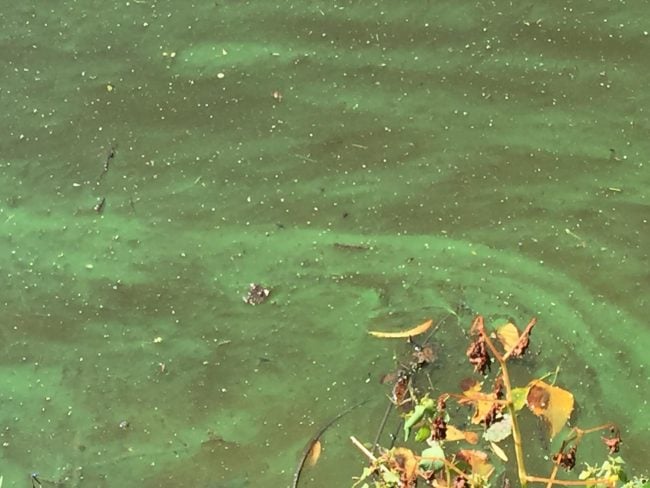Another Potentially Harmful Algae Bloom on the Wallkill River

Algae observed August 16, 2016, on the Wallkill River near Rifton. (Photo by Jason West / Wallkill River Watershed Alliance)
View more images on our Flickr site
The Wallkill River Watershed Alliance and Riverkeeper have documented and reported to the Department of Environmental Conservation another potentially Harmful Algal Bloom (HAB) on the Wallkill River.

Algae observed August 16, 2016, on the Wallkill River near Rifton. (Photo by Jason West / Wallkill River Watershed Alliance)
Last year about at this time, the Wallkill turned bright green from bank to bank along a two-mile stretch in New Paltz, and analysis of samples by Jillian Decker, Ph.D., of SUNY Rockland confirmed the presence of potentially harmful algae similar to the algae that has led to headline-grabbing attention for wreaking havoc on recreational waters, drinking water supplies and wildlife in South Florida, Lake Erie and elsewhere.
This year, microcystis was documented in water samples taken from the Wallkill on August 15 and 16 in the Rifton area, above Sturgeon Pool. Toxins produced by some strains of species in this genera of cyanobacteria are the concern. People (as well as wildlife, dogs and farm animals) may be exposed to toxins from harmful algal blooms by drinking water downstream of a bloom (toxins may travel much farther than algae is visible), by ingesting toxins during recreation, touching the water, or by breathing airborne toxins near the algae. Health effects may range from skin rashes to liver and kidney damage, and neurological damage. Dogs have been known to die from exposure from swimming in harmful algal blooms.
At this point, we know only that one of the three worrisome genera of algae was present, but not if toxins were being produced. We have requested help from the Department of Environmental Conservation in developing a plan to test for toxins, to know if the Wallkill algae is producing toxins.

Microcystis algae cells were identified by Jillian Decker, Ph.D., and John Gotto, Ph.D. (Photo by Jillian Decker / SUNY Rockland)
Additional analysis is planned of algae by Decker and John Gotto, Ph.D., of SUNY Ulster, and of nutrients by Neil Bettez, Ph.D., of SUNY New Paltz and the Cary Institute. These scientists volunteer their time to assist the Wallkill River Watershed Alliance. Their analysis will help to shed light on the extent and duration of potentially harmful algae blooms, the underlying conditions that allow this algae to form, and ultimately priority projects to restore healthy watershed conditions that will prevent future algae blooms.
The Wallkill River is known to suffer from an excess of nutrients, derived from sources such as sewage and fertilizers applied to farms and lawns. Just the appearance of algae may be a violation of New York’s Water Quality Standards, which state that nutrients should not be present “in amounts that result in the growths of algae, weeds and slimes that will impair the waters for their best usages.” In the case of the Wallkill in the areas photographed here, the best uses of these Class B waters includes swimming, boating and fishing — which would be impaired by the presence of this much algae, whether or not it produces toxins. When algae dies off, it consumes oxygen, which can stress or kill fish and other life in the water.
This stretch of the Wallkill is used for swimming (particularly in Sturgeon Pool), as well as for hiking, boating, fishing and other recreation. Extensive public use occurs downstream in the Rondout Creek, and drinking water intakes in the Hudson River for Port Ewen and Rhinebeck are approximately 10 miles downstream of where algae was observed.
The Hudson itself is “the most heavily nutrient-loaded estuary in the world”, with huge inputs dominated by sewage-related sources in the densely populated lower estuary, lawn fertilizer-related inputs in New York City’s near suburbs in the lower Hudson region, by farm fertilizer or a combination of sources in the upper reaches of the estuary, and by the deposition from fossil fuel combustion, according to the research of Robert W. Howarth and Roxanne Marino of Cornell University and others. But unlike the Gulf of Mexico, Chesapeake Bay or other coastal estuaries that suffer from seasonal dead zones related to excess nutrients, the Hudson is generally resistant to the worst consequences of this nutrient overload because it flushes relatively quickly, so the right conditions for algal blooms rarely occur. The risk of impacts from nutrient overload may increase with climate change, if summer droughts drain freshwater from the system, reducing the system’s self-flushing ability.
The community science projects that made these Wallkill River observations possible are funded in part by the Environmental Protection Fund, via the Hudson River Estuary Program. In addition to Decker, Gotto and Bettez, assistance necessary to prepare this report came from Bill Fetter, Jason West, Beckett Lansbury and Jen Epstein, proving that it does take a community to do this kind of science.
If you see algae on the Wallkill River you want to report, please use this Wallkill River Watershed Alliance Harmful Algal Bloom Monitoring Program Observation Form.

